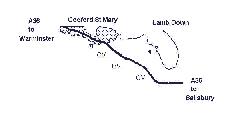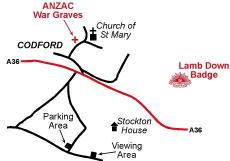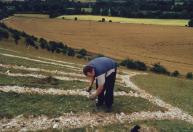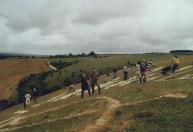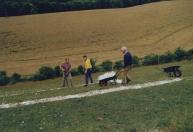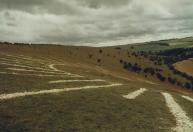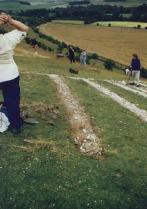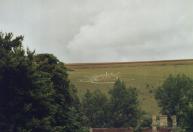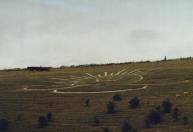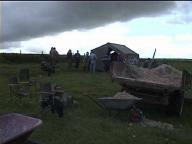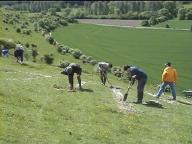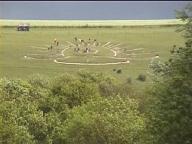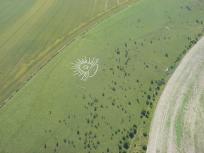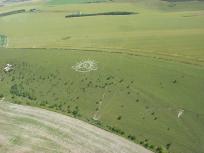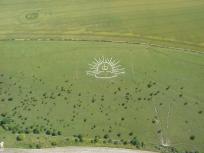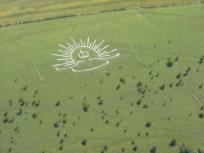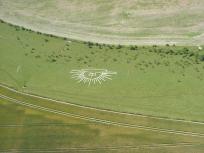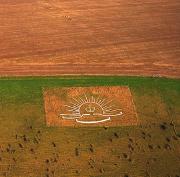Lamb Down Military Badge
In Conjunction with the Lamb Down Military Badge Preservation Committee
General Information
National Grid Ref ST 98393939
The badge of the Australian Commonwealth Military Forces cut on a steep slope just by the A36,at the top of Lamb down. The badge is fenced in and is of the same design as one cut at Fovant although not nearly as detailed in its design. It is good condition. The Lamb Down badge is on the private property of Mr Stratton.
Members of the Parish council, the landowner and the Australian exchange officer at Warminster form the committee which is responsible for the maintenance and care of the badge.
History
Cut in 1916-1917 by Australian troops stationed at the local Codford and Sutton Veny military camps. The badge is based on a the cap badge of the Australian Army, this design is also on the camp gates which has recently been acquired by the Warminster Historical Society and Dewey Museum, Warminster.
The then Australian Brigade Commander of the near by Australian garrison, would gaze out from the reading room at Stockton House and came up with the idea of leaving his mark on the English countryside. His decision led to defaulters carving out a rising sun badge in the chalk on the hillside. The initial work on the badge was started by the 13th Training Battalion, Australian Imperial Forces (AIF). The badge was then embedded with green, brown and clear beer bottles to make it shine bronze like the badge worn on the Australian uniform. Maintaining the badge became the focus of punishment parades and as a result, the spur on which it is carved was affectionately known as Misery Hill by Australian troops.
The badge remained untouched until WW2 when it was covered over to prevent enemy aircraft using it as a navigation aid. After the war it was uncovered, however most of the glass had either washed away or sunk into the chalk below.
History of the Rising Sun Badge.
In 1885, Major (later Major General) Joseph Maria Gordon, the first Commander at Fort Glanville, designed a trophy to symbolise the military skill of defense. It consisted of a series of bayonets radiating out in a semi-circle from a crown.
Major-General Sir Edward Hutton, the newly appointed first Commander-in-Chief of the Australian Forces used this trophy as an inspiration when he requested a General Service Badge to be worn by the Australian soldiers in South Africa. And so it was that in 1902 the first Rising sun badges were worn with pride by the troopers of the 1st Battalion Australian Commonwealth Horse, which was raised after Federation.
The Lamb Down Badge is approximately 175ft by 150ft tall. The badge derives its name from the pasture in which it is carved, Lamb Down. The outline of the badge remains to this day and due to the nature of the badge; chalk, it requires annual maintenance. Each year, members of the Australian Army stationed in England and the local community gather to refurbish the badge, as a memorial to the Australians who came here, and died, in the two great conflicts.
Maps
Photos
Restoration July 2001
After Restoration
Restoration May 2000
General Photos
Aerial Photos
The Badge viewed from the Australian Camp at Codford St Mary at the bottom of misery
Hill.

Stockton house with the badge in the top left hand corner, (This is the view as the Brigade commander saw it when it was being carved in 1917.)
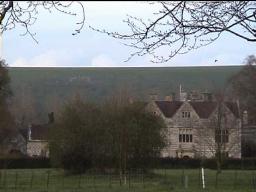
The second is a close up view of the badge
from stockton house
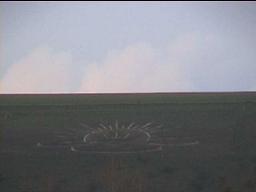
Lamb Down badge as it appeared in 1918
A picture of the similar badge at Sutton Down Courtesy of Australia House,
Reproduced with kind permission of Dae Sasitorn and Adrian Warren - www.lastrefuge.co.uk
References
Bergamar, K. (1997) Discovering Hill Figures. 4th edn. Princes Risborough: Shire. 70.
More information about the local area can be found on Sutton Veny Website
